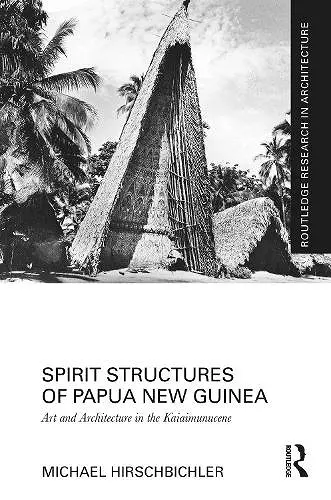Spirit Structures of Papua New Guinea
Art and Architecture in the Kaiaimunucene
Format:Hardback
Publisher:Taylor & Francis Ltd
Published:21st Jun '24
Currently unavailable, and unfortunately no date known when it will be back

This book investigates the art and architecture of Papua New Guinean spirit structures with a multi-perspectival approach that combines cultural and social sciences with building, architectural, and spatial research. It offers the first comprehensive study of the spirit houses of New Guinea that exists to date.
The book’s aim is twofold: First, it aims to investigate the spirit structures and their associated cultural cosmos in detail. For this purpose, a representative selection of traditional buildings and artworks from different regions of Papua New Guinea is documented and analyzed, and theories for their understanding are formulated. In this course, the author develops a spatial theory of anthropological concepts – such as myths, signs, persons, and rituals. Secondly, this analysis is then situated in the broader context of the Anthropocene/Kaiaimunucene. Transforming the historical spirit structures into models for future-oriented cultural imagination, the consequences for contemporary productions of space and ways of worldmaking in light of existential challenges are traced.
The book thus offers more-than-human and more-than-secular concepts for building, art, and worldmaking that are of critical importance in the ongoing Anthropocene/Kaiaimunucene. It will be of interest to researchers and students of architecture, anthropology, cultural studies, environmental humanities, and adjacent disciplines.
Part I of the book was translated from German by Melanie Janet Sindelar.
If it is the author’s combined technical and ethnographic expertise that leads to this highly original evocation of a particular kind of Anthropocene, it is spirit houses that structure the tension between the presence of past ghosts and the future orientation of Papua New Guinean cultures as a profound illumination of architectural space.
Marilyn Strathern, University of Cambridge.
With this book Michael Hirschbichler accomplishes a dazzling tour de force, straddling both anthropology and architecture. This is truly an innovative work that through masterful synthesis contributes with a fresh perspective on one of today’s greatest challenges. It deserves a wide readership.
Ton Otto, Aarhus University and James Cook University.
Spirit Structures of Papua New Guinea is a powerful contribution to the expanding field of global history. Meticulously and brilliantly researched, the book helps us better understand the nuances and inner workings of the relationship between building, society and the cosmos that the spirit structures embody.
Mark Jarzombek, Massachusetts Institute of Technology.
This book is a creative, inspiring and significant addition to the study of vernacular architecture. It represents a major advance in the expanding field of architectural anthropology/spatial studies. Its combination of rigorous scholarship, with brilliant theoretical insights, pushes this emerging field in exciting and challenging new directions.
Christopher Wright, Goldsmiths.
Michael Hirschbichler’s fascinating book puts ethnographic storytelling to work, moving from the story of Papua New Guinean spirit structures to the making of ‘other’ stories and geostories for contemporary world-making – a radical story in its own right.
Marc Angélil, ETH Zurich and Harvard GSD.
Hirschbichler’s trans-disciplinary and comparative study of ceremonial houses in Papua New Guinea provides a fascinating insight into the way in which these cultures created architectural and cosmological masterpieces. Myth, rituals and sociality are bundled in these huge buildings that represent a meaningful landscape of life in its multi-dimensionality. A superb book.
Brigitta Hauser-Schäublin, University of Göttingen.
This jewel for world cultural knowledge, unlocks the hitherto lost secrets of the architecturally spectacular spirit house tradition of Papua New Guinea. Michael Hirschbichler starts with the cosmological belief system embedded in cultural landscapes, laying the ontological foundations of human lifeways in the spirit world, then unpacks the saturated symbolism and ritual of these spirit structures.
Paul Memmott, The University of Queensland.
This book tackles one of the most demanding intellectual and political problems of the present: How to relate to conceptual and material worlds that were (co)-constructed in a colonial past? The semipermeable weaves of the spirit houses are an excellent medium to get in touch with both Australasian and Western (scientific) mythmaking.
Karin Harrasser, University of Arts Linz.
ISBN: 9781032412443
Dimensions: unknown
Weight: 690g
270 pages